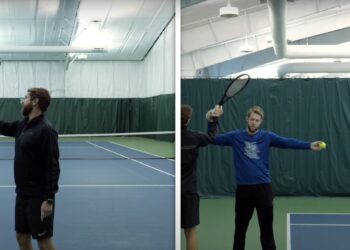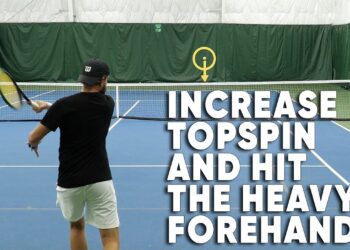This article is for players who want to relieve pain, heal quickly, and prevent tennis elbow from coming back.
What Is Tennis Elbow And Why Do You Have It?
Tennis elbow, or “lateral epicondylitis” is a gnarly little overuse injury that messes with the tendons on the outside of your elbow.
Those tendons? They’re responsible for gripping, lifting, and pretty much every move you make on a tennis court.
Now here’s where most people go wrong: they treat the elbow without ever looking at the rest of their body.
What finally helped me is realizing my shoulder wasn’t doing its job, my wrist was compensating, and my poor elbow was caught in the crossfire.
Pro Tip: If your elbow hurts, don’t just blame your backhand. It could be your weak shoulder, stiff wrist, or even bad footwork forcing your arm to work overtime.
Source -> NHS Inform
Will Tennis Elbow Ever Go Away? (And How Long Does It Take to Heal?)
If you try to tough it out, slap on a brace, and keep swinging away like nothing’s wrong, you’re looking at a 6 to 12-month grind.
And that’s if you’re lucky.
I’ve seen players deal with it for years because they never addressed the root cause.
Now, if you actually treat it the right way, using physical therapy, correcting your form, and making small changes to how you train and play, you can start seeing real progress in as little as 4 to 8 weeks.
That’s not hype, that’s science.
And it’s the exact reason we bake physical therapy-style rehab directly into our PlayYourCourt coaching programs.
Here’s what drags healing out:
- Reinjury. You think it’s better, you jump back in full-speed, and boom – it’s back.
- Bad form. If your technique is off or your shoulder is not pulling its weight, your elbow picks up the slack and pays the price.
- Rushing recovery. This one’s tough, especially for competitive players. But pushing too hard too soon is the fastest way to stall your progress.
The Best Physical Therapy Exercises for Tennis Elbow Relief
There’s a clear path to healing, and it happens in three smart, progressive stages. Each one builds on the last, so you’re not just patching pain…you’re fixing the problem for good.
Stage 1 – When You’re in Pain (Acute Phase)
If your elbow is flaring up right now, your job isn’t to power through, it’s to reset the system.
Start here:
- Rest + Ice. Not forever – just enough to calm the fire. 15-20 minutes of ice a few times a day can help reduce inflammation and kickstart healing.
- Brace or Strap (Short-Term). A forearm strap can reduce tension on the tendon while you move through daily life. It’s not a cure, but it gives your body a breather.
- Gentle Wrist Extensor Stretch. Arm out, palm down, gently press your hand down with the other hand. No pain, just a stretch.
- Fist Squeezes. Use a towel or stress ball. Hold for 10 seconds, release. This increases blood flow and starts activating those deeper forearm muscles.
Stage 2 – Rebuild Strength (Active Rehab Phase)
Once the fire’s out, it’s time to rebuild.
This is where most people go wrong, they stop too soon, and the injury comes right back.
But if you want real relief, you have to strengthen the system.
Here’s your toolkit:
- Wrist Extensions & Flexions. Use a light dumbbell (or even a can of soup). Slowly lower and lift your wrist with control.
- Towel Twists. Just like wringing out water, but this time it’s rehabbing your grip and rebalancing forearm tension.
- Supination with Dumbbell. Hold a hammer or small weight vertically, then rotate your palm up and down. It’s simple, but most people skip it.
- Shoulder Band Stabilizers. Your shoulder is your elbow’s shock absorber. Use a resistance band to do internal and external rotations. Weak shoulder = overworked elbow.
New Insight: Most cases of tennis elbow aren’t just about the elbow. They’re about a weak shoulder and lazy wrist control. This is where you fix that.
Stage 3 – Tennis-Specific Strength & Return to Play
Here’s where we bring it back to the court – and this is where PlayYourCourt really shines.
Besides hitting the balls, our coaching is about building athletes who move better, hit cleaner, and stay healthy. We put injury prevention into every drill.
Your game-ready phase should include:
- Plyometric Wrist Slaps. Quick, controlled flicks using a resistance band. Builds power and stability at match speed.
- Forearm Pronation Drills. Rotate palm down against resistance to bulletproof your forearm.
- Pre-Match Warmups with Grip Activation. Don’t skip these. Our video warmups target the exact muscles that keep your elbow safe under pressure.
Unique Take: Most rehab feels like a chore. We turn it into part of your game plan. You don’t need to “find time” for separate therapy, it’s already built into how we coach. That’s the PlayYourCourt way.
What NOT to Do When You Have Tennis Elbow
Let’s talk about what not to do.
Because even with the best intentions, a lot of players slow down their recovery or worse by making one of these classic mistakes.
Let’s steer clear of these traps:
❌ Don’t Jump Into Heavy Weights Too Early
You feel a little better, and you grab a 15-pound dumbbell thinking you’re ready to rebuild.
Nope.
That’s a fast-track to starting over from square one. Your forearm tendons need gradual, progressive loading.
❌ Don’t Over-Ice
Yes, ice is great in the early phase. But too much of it for too long? That actually slows down blood flow, which means your body can’t send healing nutrients where they’re needed.
Limit icing to 15–20 minutes at a time, a few times a day.
❌ Don’t Become Dependent on a Brace
Braces are tools, not crutches.
A forearm strap can give you short-term relief, but if you wear it all day, every day, your muscles start relying on it.
You’ve got to wean off as you get stronger, or you’re just band-aiding the problem.
❌ Don’t Ignore the Real Problem Areas
This might be the biggest one of all.
If you’re only stretching your forearm and doing wrist curls, you’re missing the bigger picture.
Tennis elbow is often a downstream issue caused by weak shoulders, tight lats, or even poor footwork.
Hidden Mistake: You’re rehabbing your elbow…but the real injury came from your shoulder not doing its job.
I say this all the time to our members: You can’t out-stretch a stability problem.
You’ve got to fix the system, starting with how you move, how you warm up, and how strong your shoulder and core really are.
5 Things You Didn’t Know Could Be Making Your Tennis Elbow Worse
Most tennis players think they’ve got a pretty good handle on what caused their elbow pain.
You probably blame your backhand, overplaying, or maybe that one day you decided to hit four buckets of serves “just to groove it in.”
But after coaching thousands of players and dealing with this beast myself, I can tell you – it’s usually not just one thing. And sometimes, the real culprits are hiding in plain sight.
Here are five sneaky saboteurs that could be secretly making your tennis elbow worse:
1. Your Grip Size Is Off
This one is so basic, but so overlooked. If your racquet grip is too small, your forearm muscles have to work overtime just to stabilize your swing. Too big? Same story, different strain.
Rule of thumb (literally): You should be able to fit a finger in the gap between your fingers and palm when gripping your racquet.
We tend to help players dial in not just their strokes, but their equipment setup too, because sometimes the fix is as simple as swapping out your overgrip.
2. Your String Tension Is Too High
Tight strings feel great for control, but they also transmit way more vibration up your arm. That added shock? Your elbow takes the hit.
If you’re dealing with tennis elbow, try loosening your string tension by 3–5 pounds or switching to a softer string.
It’s an instant stress reliever for your gear and your tendons.
3. Your Footwork Is Causing Arm Overuse
Poor footwork means you’re constantly late to the ball. And when you’re late, you muscle your shots.
That’s where the elbow strain creeps in.
Good movement = clean timing = less arm tension.
4. You Skip Warm-ups (Especially for Your Wrists)
You’d never sprint full-speed without warming up your legs, but most players jump into hard hitting without so much as a wrist roll.
You should start every session with wrist-specific activation drills, such as band flicks, grip pulses, forearm stretches.
They take 3–5 minutes and drastically reduce your injury risk.
Warming up your wrist = protecting your elbow.
5. You’re Only Doing “Flexion” Exercises
If all your rehab work is focused on curling your wrist (flexion), you’re missing the whole back half of your forearm.
And guess what? That’s where tennis elbow actually lives.
You need a balanced routine that includes wrist extensions, supination, grip strength, and shoulder stability, not just endless curls.
Tennis elbow comes also from imbalanced use.
Fix these five things, and you’ll not only heal faster, you’ll become a better, more resilient player.
How to Keep Tennis Elbow From Coming Back – for Good
So you’ve done the rehab, you’re finally pain-free, and you’re back on the court. Feels great, right?
This is where most players mess up.
They stop doing the work that got them healthy in the first place. And just like that, the pain creeps back.
If you want to make sure tennis elbow stays in your rearview mirror for good, here’s how to bulletproof your body and game:
Keep Grip + Wrist Strength High
Don’t wait until your elbow flares up to start squeezing a towel or working your extensors. These little muscles fatigue fast and need consistent training.
- Keep doing towel twists and fist squeezes a few times a week.
- Add light wrist curls and extensions into your off-court routine.
🏋️♂️ Maintain Shoulder Stability
Your shoulder is your elbow’s first line of defense.
When it’s weak or unstable, your elbow takes on way more stress than it’s built for.
That’s why PlayYourCourt’s training includes rotator cuff band work and scapular stability drills.
You don’t need a gym, just a resistance band and a little consistency.
Use Structured Rest Days
More isn’t always better – especially with tennis.
Our players follow deliberate training cycles that build in rest, light hitting, and strength work between high-volume sessions.
That way, your arm gets time to recover and rebuild without losing momentum.
Think of it like strength training: lift, rest, grow. Same rule applies to your tennis arm.
Reassess Your Gear and Technique
Your game evolves and your gear should evolve with it.
- Double-check your grip size, string tension, and racquet weight.
- Review video of your strokes. What felt “fine” 6 months ago might be putting new strain on your arm today.
- Make sure your tension free and not gripping the racquet too hard.
Focus on Full-Body Movement
If your legs are lazy, your arm works harder. Period.
When your footwork is clean, your contact point is clean. And when your contact point is clean, your elbow doesn’t have to grind out every shot.
That’s why we train the full kinetic chain – agility, balance, core rotation, shoulder stability.
Tennis is a total-body sport, and your elbow is one piece of the puzzle.
Bottom line: if you want to stay healthy, don’t wait for pain to remind you. Stay ahead of it.
And remember – injury prevention isn’t a chore. When it’s built into your training, it’s part of getting better.
Ready to Heal and Level Up?
Tennis elbow is brutal.
But the truth is, healing it doesn’t have to mean sitting out or spending thousands on physical therapy sessions that barely understand your sport.
Our membership is your all-in-one game improvement system, with guided challenges, injury-friendly drills, strength programs, and video coaching baked right into your training.
From pain-free performance tips to custom rehab-friendly workouts you can actually do on the court, we’ve built a smarter way to get better.
👉 Explore our membership and start improving today – your elbow (and your backhand) will thank you.



